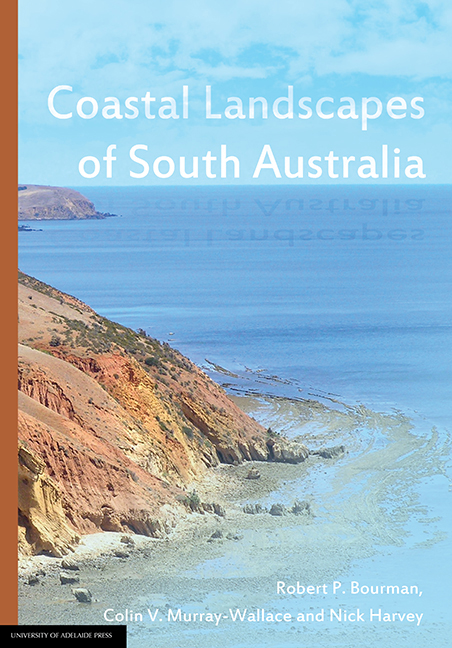Book contents
- Frontmatter
- Dedication
- Contents
- Preface
- Biographies
- Acknowledgements
- 1 Coastal landscapes of South Australia
- 2 The coast of metropolitan Adelaide
- 3 The Fleurieu Peninsula coast
- 4 The River Murray Estuary
- 5 The Coorong Coastal Plain and the Limestone Coast
- 6 The northern Gulf St Vincent tidal coastline (the Samphire Coast)
- 7 The Yorke Peninsula coastline
- 8 The northern Spencer Gulf coast
- 9 The Gulf Coast of Eyre Peninsula
- 10 The Bight Coast - West coast of Eyre Peninsula
- 11 Kangaroo Island
- 12 Explaining the coastal landscapes of South Australia - A synthesis
10 - The Bight Coast - West coast of Eyre Peninsula
Published online by Cambridge University Press: 25 July 2017
- Frontmatter
- Dedication
- Contents
- Preface
- Biographies
- Acknowledgements
- 1 Coastal landscapes of South Australia
- 2 The coast of metropolitan Adelaide
- 3 The Fleurieu Peninsula coast
- 4 The River Murray Estuary
- 5 The Coorong Coastal Plain and the Limestone Coast
- 6 The northern Gulf St Vincent tidal coastline (the Samphire Coast)
- 7 The Yorke Peninsula coastline
- 8 The northern Spencer Gulf coast
- 9 The Gulf Coast of Eyre Peninsula
- 10 The Bight Coast - West coast of Eyre Peninsula
- 11 Kangaroo Island
- 12 Explaining the coastal landscapes of South Australia - A synthesis
Summary
Introduction
Extending from the Western Australian border near Wilson Bluff to Cape Carnot and Cape Wiles, south of Port Lincoln, this section of coast covers approximately 1400 km. Although it is the longest section of coastline described in this book, it has sufficient integrity to consider it a discrete unit. The west coast of Eyre Peninsula forms the eastern side of the Great Australian Bight, the general shape of which was inherited from the continental rifting and separation from Antarctica some 43 Ma ago. There is not a perfect jigsaw fit of the current Australian and Antarctic coasts, but if the edges of the continental shelves, which separate continental and oceanic crust, are used, then the fit is much better. All of the coastline is underlain by crystalline rocks (granites, gneisses, volcanic rocks and metamorphosed sediments) of the ancient and highly stable Gawler Craton (Figure 10.1).
The Bight coastline has remained tectonically stable during the Pleistocene. On Eyre Peninsula there is no spectacular sequence of Pleistocene coastal dune barriers as in the southeast of South Australia, where the land has been progressively uplifted to record successive interglacial high sea levels. The stability of the Gawler Craton, which underlies Eyre Peninsula, caused succeeding interglacial high sea levels to merge, rework and overlap with the previous ones. However, distinct Eocene shorelines in the Eucla Basin are marked by coastal barrier systems similar to the modern Murray Mouth and Coorong, forming relict strandlines, lagoons, estuaries, coastal barriers and extensive coastal sand dunes and beach ridges some 300 km inland of the modern coastline (Figure 10.2).
Ongoing stability of the coast since the Last Interglacial (132 to 118 ka) is indicated by the constant elevation of marine shells of that age along the shoreline. Marine shells including the subfossil Anadara trapezia occur at a consistent height of near 2 m APSL, so they have been little affected by land movements, as they have in other parts of the State. The presence of Anadara indicates that inner shelf waters were warmer, accentuated by an enhanced Leeuwin Current, which moves south along the western side of Australia before flowing easterly along the Great Australian Bight.
Aeolianite (dune calcarenite) blankets the landscape along the coast and well inland. Aeolianite consists of former coastal sand dunes up to 100 m high which have been lithified (that is, turned into a harder rock).
- Type
- Chapter
- Information
- Coastal Landscapes of South Australia , pp. 309 - 354Publisher: The University of Adelaide PressPrint publication year: 2016



